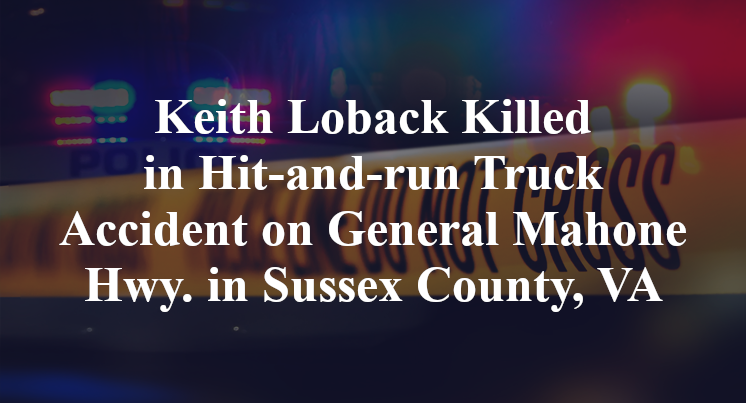Keith Loback Killed in Hit-and-run Truck Accident on General Mahone Hwy. in Sussex County, VA
Sussex County, VA — July 10, 2025, Keith Loback was killed due to a hit-and-run truck accident at about 2:45 p.m. along General Mahone Highway.
According to authorities, 64-year-old Keith Michael Loback was traveling in a westbound Freightliner 18-wheeler on General Mahone Highway in the vicinity northwest of the Spring Branch Road intersection when the accident took place.

Officials indicate that, for as yet unknown reasons, the load cover on an eastbound truck (apparently constructed of canvas tarp and metal framing—became detached from its commercial vehicle. It reportedly struck the driver's side of the Freightliner's windshield, causing Loback to lose consciousness. The Freightliner consequently veered left, crossing over the eastbound lanes and leaving the roadway before crashing into several trees.
Loback reportedly sustained fatal injuries due to the wreck and was declared deceased at the scene. The truck from which the load cover was lost allegedly did not stop; authorities state that the person who had been behind the wheel of the fleeing vehicle has been located.
Additional details pertaining to this incident are not available at this point in time. The investigation is currently ongoing.
Commentary by Attorney Michael Grossman
When a professional driver is killed because another truck’s equipment wasn’t properly secured, the issue isn’t limited to one bad outcome—it points to a failure in basic commercial vehicle safety. There’s no gray area in the rules about load securement: anything attached to a truck, whether it’s a load, a tarp, or frame hardware, must be fastened so that it stays in place under normal highway conditions. If that doesn’t happen, and someone dies as a result, the responsibility is clear.
At this stage, investigators should be asking whether the equipment that came loose had been properly inspected, maintained, or even appropriate for highway use to begin with. In similar cases I’ve handled, it’s often not the first time a piece of equipment has come loose—but it’s the first time the consequences were deadly. That’s why it’s critical to look beyond the crash and into the vehicle’s inspection records, prior violations, and the company’s maintenance history.
Another point that can’t be overlooked is what the driver of the other truck did—or didn’t do—after the incident. Failing to stop after a part of your vehicle has caused a deadly crash isn’t just a violation of basic decency. It’s a serious legal issue, especially in the commercial trucking world where post-accident obligations are well understood. If the driver kept going out of fear or to avoid consequences, that decision only compounds the original act of negligence.
The larger concern here is preventability. Equipment doesn’t detach and strike another vehicle unless someone failed to secure it. That kind of failure reflects not just on the driver, but possibly on the company that allowed that vehicle on the road. If oversight was missing—if the equipment was makeshift, uninspected, or patched together—then the fault runs deeper than just one bad decision.
Key Takeaways
- The central issue is a failure in load securement—a basic and non-negotiable responsibility in commercial trucking.
- Investigators should examine inspection and maintenance records to determine whether the equipment had a known history of problems.
- The truck driver’s failure to stop raises serious legal concerns about post-incident conduct and accountability.
- Carrier oversight may come under scrutiny if poor safety practices allowed unsafe equipment to be used or overlooked.
- Accountability in a case like this isn’t limited to what happened on the road—it includes every decision that let unsafe equipment get there.

“These are essential reads for anyone dealing with the aftermath of a truck wreck”– Attorney Cory Carlson